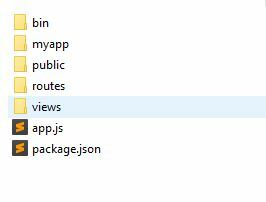In this tutorial, you will learn how to create user login and registration application using node js + express js + MongoDB database.
Login and Registration Form in Node JS Express MongoDB
Steps to build registration and login form:
Step 1 – Install Node JS Express App and Modules
Run the following command on cmd to create a new directory for the node js login and registration system with Mongodb:
express --view=ejs myApp
Run the following command:
cd myApp
Your node express js app structure looks like:

Install some required node module; so open again your cmd and run the following commands:
npm install npm install express-flash --save npm install express-session --save npm install mongoose npm install passport passport-local --save npm install passport-local-mongoose --save npm install body-parser --save
Step 2 – Connect Node js Express with MongoDB
Create a new file name database.js in application root directory:
var mongoose = require('mongoose');
mongoose.connect('mongodb://localhost/node-mongodb', {useNewUrlParser: true});
var conn = mongoose.connection;
conn.on('connected', function() {
console.log('database is connected successfully');
});
conn.on('disconnected',function(){
console.log('database is disconnected successfully');
})
conn.on('error', console.error.bind(console, 'connection error:'));
module.exports = conn;
Step 3 – Create Model
Create directory name Models, and inside this directory, create a userModel.js file:
var mongoose = require('mongoose');
var Schema = mongoose.Schema;
var userSchema = new Schema({
name: String,
email: String,
password: String
});
var User = mongoose.model('User', userSchema);
However, with version 5 and above, the Schema constructor is now exported directly and you should require it in the following way:
var mongoose = require('mongoose');
var userSchema = new mongoose.Schema({
name: String,
email: String,
password: String
});
var User = mongoose.model('User', userSchema);
Step 4 – Import Modules and Create routes in app.js
Import modules and create login and registration routes in app.js file; So visit your app root directory and open app.js file in any text editor; then add the following code into it:
var express = require("express");
var mongoose = require("mongoose");
var passport = require("passport");
var bodyParser = require("body-parser");
var LocalStrategy = require("passport-local");
var passportLocalMongoose = require("passport-local-mongoose");
var User = require("./models/userModel");
var app = express();
app.set("view engine", "ejs");
app.use(bodyParser.urlencoded({ extended: true }));
app.use(require("express-session")({
secret: "node js mongodb",
resave: false,
saveUninitialized: false
}));
app.use(passport.initialize());
app.use(passport.session());
passport.use(new LocalStrategy(User.authenticate()));
passport.serializeUser(User.serializeUser());
passport.deserializeUser(User.deserializeUser());
//=====================
// ROUTES
//=====================
// Showing home page
app.get("/", function (req, res) {
res.render('register', {
title: 'Registration Page',
name: '',
email: '',
password: ''
})
});
// Showing secret page
app.get("/home", isLoggedIn, function (req, res) {
res.render("home");
});
// Showing register form
app.get("/register", function (req, res) {
res.render('register', {
title: 'Registration Page',
name: '',
email: '',
password: ''
})
});
// Handling user signup
app.post("/register", function (req, res) {
var email = req.body.email
var password = req.body.password
User.register(new User({ email: email }),
password, function (err, user) {
if (err) {
console.log(err);
return res.render("register");
}
passport.authenticate("local")(
req, res, function () {
req.flash('success', 'You have logged in')
res.render("home");
});
});
});
//Showing login form
app.get("/login", function (req, res) {
res.render('login', {
title: 'Login',
email: '',
password: ''
})
});
//Handling user login
app.post("/login", passport.authenticate("local", {
successRedirect: "/home",
failureRedirect: "/login"
}), function (req, res) {
});
//Handling user logout
app.get("/logout", function (req, res) {
req.logout();
res.redirect("/");
});
function isLoggedIn(req, res, next) {
if (req.isAuthenticated()) return next();
res.redirect("/login");
}
var port = process.env.PORT || 3000;
app.listen(port, function () {
console.log("Server Has Started!");
});
Step 5: Create Login and Registration Views
Create login and registration views; so visit the views directory and create the following views file into it:
- login.ejs
- register.ejs
- home.ejs
Now, open your login.ejs file and update the following code into your file:
<!DOCTYPE html>
<html>
<head>
<title><%= title %></title>
<script src="https://code.jquery.com/jquery-3.4.1.min.js"></script>
<script src="https://cdnjs.cloudflare.com/ajax/libs/popper.js/1.14.3/umd/popper.min.js"></script>
<script src="https://stackpath.bootstrapcdn.com/bootstrap/4.1.3/js/bootstrap.min.js"></script>
<link rel="stylesheet" href="https://stackpath.bootstrapcdn.com/bootstrap/4.1.3/css/bootstrap.min.css">
</head>
<body>
<% if (messages.error) { %>
<p style="color:red"><%- messages.error %></p>
<% } %>
<% if (messages.success) { %>
<p style="color:green"><%- messages.success %></p>
<% } %>
<form action="/login" method="post" name="form1">
<div class="form-group">
<label for="exampleInputEmail1">Email</label>
<input type="email" name="email" class="form-control" id="email" aria-describedby="emailHelp" placeholder="Enter email" value="">
</div>
<div class="form-group">
<label for="exampleInputEmail1">Password</label>
<input type="password" name="password" class="form-control" id="password" aria-describedby="emailHelp" placeholder="*********" value="">
</div>
<input type="submit" class="btn btn-primary" value="Add">
<a href="auth/register" class="btn btn-success ml-2">Register Here</a>
</form>
</body>
</html>
Now, open your register.ejs file and update the following code into your file:
<!DOCTYPE html>
<html>
<head>
<title><%= title %></title>
<script src="https://code.jquery.com/jquery-3.4.1.min.js"></script>
<script src="https://cdnjs.cloudflare.com/ajax/libs/popper.js/1.14.3/umd/popper.min.js"></script>
<script src="https://stackpath.bootstrapcdn.com/bootstrap/4.1.3/js/bootstrap.min.js"></script>
<link rel="stylesheet" href="https://stackpath.bootstrapcdn.com/bootstrap/4.1.3/css/bootstrap.min.css">
</head>
<body>
<% if (messages.error) { %>
<p style="color:red"><%- messages.error %></p>
<% } %>
<% if (messages.success) { %>
<p style="color:green"><%- messages.success %></p>
<% } %>
<form action="/register" method="post" name="form1">
<div class="form-group">
<label for="exampleInputEmail1">Name</label>
<input type="name" name="name" class="form-control" id="name" aria-describedby="nameHelp" placeholder="Enter name" value="">
</div>
<div class="form-group">
<label for="exampleInputEmail1">Email</label>
<input type="email" name="email" class="form-control" id="email" aria-describedby="emailHelp" placeholder="Enter email" value="">
</div>
<div class="form-group">
<label for="exampleInputEmail1">Password</label>
<input type="password" name="password" class="form-control" id="password" aria-describedby="emailHelp" placeholder="*********" value="">
</div>
<input type="submit" class="btn btn-primary" value="Add">
<a href="auth/login" class="btn btn-success ml-2">Login</a>
</form>
</body>
</html>
This login.ejs file contains login form.
Next, open your home.ejs file and update the following code into your file:
<!DOCTYPE html>
<html>
<head>
<title><%= title %></title>
<script src="https://code.jquery.com/jquery-3.4.1.min.js"></script>
<script src="https://cdnjs.cloudflare.com/ajax/libs/popper.js/1.14.3/umd/popper.min.js"></script>
<script src="https://stackpath.bootstrapcdn.com/bootstrap/4.1.3/js/bootstrap.min.js"></script>
<link rel="stylesheet" href="https://stackpath.bootstrapcdn.com/bootstrap/4.1.3/css/bootstrap.min.css">
</head>
<body>
<div class="container">
<% if (messages.error) { %>
<p style="color:red"><%- messages.error %></p>
<% } %>
<% if (messages.success) { %>
<p style="color:green"><%- messages.success %></p>
<% } %>
<div class="card">
<div class="card-header">
Dashboard <b><%= name %></b>
</div>
<div class="card-body">
<h5 class="card-title">Welcome</h5>
<p class="card-text">You have successfully login</p>
<a href="logout" class="btn btn-primary">Logout</a>
</div>
</div>
</div>
</body>
</html>
Step 6: Run Development Server
You can use the following command to run development server:
//run the below command npm start after run this command open your browser and hit http://127.0.0.1:3000/
Conclusion
Node js + MongoDB user login and registration form example. In this tutorial, you have learn how to create user registration and login authentication application using node js + express js + MongoDB database.
Thanks! This really helped !